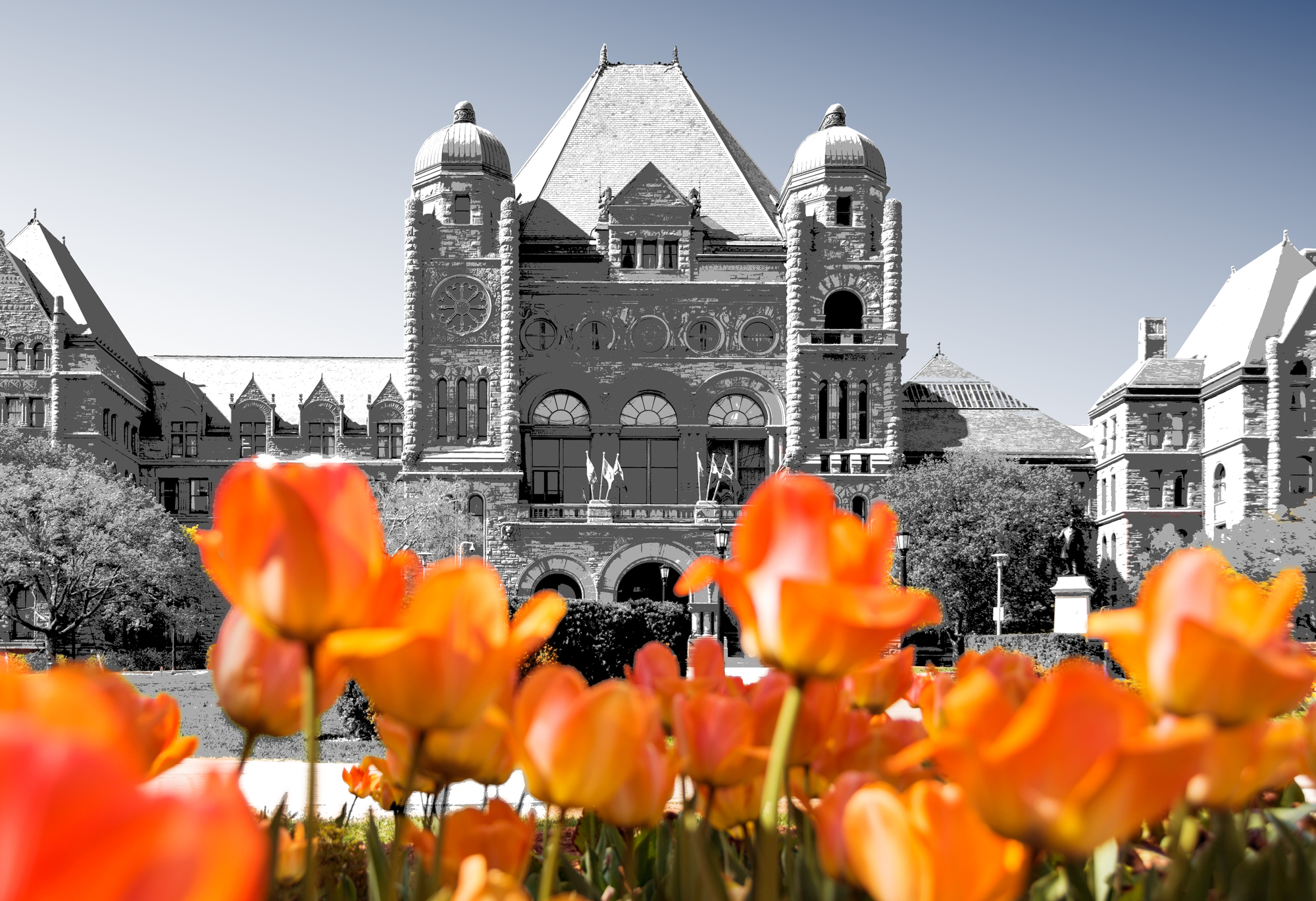State of play
As the Ontario legislature winds down for the summer, Premier Doug Ford and the Progressive Conservative government have been busy trying to wrap up some major initiatives after their successful election campaign, all the while managing crumbling Canada-U.S. relations, and leading the charge on dismantling barriers to interprovincial trade. With the legislature scheduled to return on October 20, MPPs will take the time to be in their constituencies and meet with stakeholders.
The opening of the provincial parliament on April 14 was followed by a Throne Speech that highlighted the priorities of the Ford government following a third majority government victory in last February’s election. The speech highlighted the government’s focus on the need to protect Ontario from tariffs, tear down internal trade barriers, prioritize projects of national interest, unlock critical minerals in the Ring of Fire, maintain energy sovereignty, invest in transportation infrastructure, grow the housing supply, keep our communities safe, and expand access to healthcare.
The annual real gross domestic product (GDP) in Ontario grew by 1.2%, slowing from previous years and falling just under Canada’s overall GDP growth of 1.6%. In 2024, Ontario was the top contributor to Canada’s economic growth with GDP growth of 1.5%. In 2025, the province’s GDP is expected to rise 0.8%, an expected decrease owing to uncertainty regarding U.S. trade and tariffs.
In April 2025, the unemployment rate increased to 7.8%, up from 7.5% in March and decreasing the most in the manufacturing sector. With the volatility and tariff threats coming out of the U.S., and several notable layoffs in the manufacturing sector, Premier Ford and his government are focused chiefly on protecting and building a more resilient economy.
Ontario’s population growth rate has slowed from 3.5% to 2.2% when comparing October 2022-2023 and October 2023 to 2024. This decrease is primarily due to fewer non-permanent residents such as work permit and study permit holders.
Ontario general election
Gambling on an early election call, Premier Doug Ford secured a third majority government following the Ontario general election held on February 27. The Conservative campaign was based on delivering strong, no nonsense, effective leadership through the Trump presidency and building a strong Ontarian economy. It was aided by both the unpopularity of Liberal Prime Minister Justin Trudeau and by a surge in nationalist sentiment in the face of threats from the Trump administration to Canada’s economic and political sovereignty. Ontarians ultimately opted for stability in giving Premier Ford his third consecutive majority mandate.
The Ford Conservatives won their majority with 80 seats and a 43% share of the popular vote. The Ontario New Democrats lost seats but managed to retain the status of Official Opposition. While the Ontario Liberals increased their share of the popular vote (30%) and secured enough seats to ensure official party status, their leader, Bonnie Crombie, did not win her riding.
Since his election, Ford has led the provinces in efforts to build ‘One Canadian Economy,’ creating partnerships and aiding in efforts to reduce interprovincial barriers to trade. Another priority has been his Primary Care Action Plan which, through $1.8 billion over four years, will help Ontarians connect with family doctors or nurse practitioners.
Canada-U.S. relationship
In March, Premier Ford met with U.S. Commerce Secretary Howard Lutnick to discuss tariffs and Ford’s threats of an electricity surcharge or cutoff. While managing to get Trump’s attention, the Premier eventually called off any plans for a surcharge. After their conversation, planned 50% tariffs on Canadian steel and aluminum were scaled back to 25%. On May 30, Trump announced he planned to double tariffs on steel and aluminum imports, bringing them back up to 50%, on June 4.
On May 21, a bipartisan resolution was introduced in the U.S. Senate to recognize the importance of the Canada-U.S. partnership to our shared trade and national security. The new U.S. Ambassador to Canada, Pete Hoekstra, also recently spoke about being confident that Canada can secure a deal to reach the lowest tariffs possible.
More recently, the U.S. Court of International Trade has ruled against many of Trump’s tariffs, declaring their implementation was an abuse of power. Certain specific tariffs on steel and aluminum were still in place while some tariffs on entire countries were reversed. The 25% tariffs on Canadian goods due to Trump’s declaration of a fentanyl emergency were removed. However, The White House made an immediate appeal to fight these reversals, and the U.S. Court of Appeals for the Federal Circuit temporarily halted the order from the federal trade court. Currently, the Trump Administration is collecting tariffs under the International Emergency Economic Powers Act.
In Ontario, as Honda recently postponed their $15 billion planned EV and battery plant, there is still interest in strengthening the provincial and national economy and pivoting away from U.S. trade reliance. The Ontario government has enacted measures to remove all U.S. alcohol from shelves, cancel the government’s $100 million contract with Starlink, and institute a Buy Ontario first, Canada second procurement policy.
Legislative status
Since reconvening in April, the provincial government was able to pass 10 pieces of legislation over the course of 23 sitting days.
Internal free trade
In line with the Ford government’s priorities to promote free trade nationwide, Bill 2, Protect Ontario Through Free Trade Within Canada Act, proposed changes to make Ontario’s economy more competitive by removing existing barriers to strengthen internal trade, reducing costs for Ontarians and promoting buy local initiatives.
Bill 2 includes Mutual Recognition Enabling (MRE) legislation that will allow the government to direct regulatory bodies to mutually recognize goods, services, and registered workers in reciprocating provinces and territories and with provincial governments. MRE legislation is intended to help diversify markets, lower the cost of business, and give Ontario residents greater access to goods made elsewhere in Canada. Bill 2 also includes measures to remove Party-Specific Exceptions from the Canadian Free Trade Agreement, expand labour mobility and promote a Direct-to-Consumer alcohol sales model.
“Building” and “Unleashing” the economy and natural resources
Economic growth was also a key legislative priority, with Bills 5 and 17 proposing significant changes towards streamlining approval processes for development and cutting red tape.
Bill 5, Protect Ontario by Unleashing our Economy Act, will speed up the process for energy and resource development by giving cabinet the authority to create special economic zones for critical projects where the government is exempt from designated laws, by reducing regulatory approvals through a “One Project, One Process” review process for mine permitting, and by creating a more streamlined permit system. Projects the bill could support include mining in the Ring of Fire and the proposed tunnel under Highway 401.
However, Bill 5 has been met with much criticism from stakeholders and notably Indigenous groups concerned with provisions that could allow companies to operate with less oversight and regulation through the exemption of complying with provincial laws or regulations in special economic zones. Concerned First Nations groups have threatened acts of civil disobedience, including blockading major highways, in opposition to the bill.
Due to the Ontario Liberals proposing thousands of last-minute amendments at the committee stage, the ruling PC government was not able to add many of their own changes before passing Bill 5 on the afternoon of June 4.
Bill 17, Protect Ontario by Building Faster and Smarter Act, 2025, also looks to reduce regulatory measures to speed up housing construction. The act includes legislative initiatives to fuel growth, encourage investments, and create jobs. Bill 17 can expand on the definition of priority projects for transit and infrastructure development, streamline processes for development initiatives, and will standardize development charges and reduce municipal fees to make homes more affordable.
Government priorities
2025 Ontario Budget: A Plan to Protect Ontario
Tabled on May 15, the 2025 Ontario Budget showcased the offensive-minded approach underlying the key priorities of the Ford government. While focussed on responding to U.S. tariffs and the resulting global economic uncertainty, the budget announced measured to stabilize the cost of living, protect Ontario workers and businesses, boost interprovincial trade, and expedite projects of interest.
The 2025 budget focused most on spending to support industries, businesses, and workers at greatest risk of facing tariff-related disruptions, as well as long-term projects that aim to shift away from reliance on U.S. trade and strengthen the provincial economy.
Some if its major provisions include $61 billion for public transit, $56 billion for health infrastructure, $30 billion for highway expansion and repair, and $30 billion for school and childcare spaces. The government also delegated $5 billion for the Protecting Ontario Account to offer tariff related support, $5 billion for the Building Ontario Fund to encourage investments for key infrastructure projects, and $500 million for a new Critical Minerals Processing Fund.
Housing
In Ontario, residential construction has declined for the third consecutive year, notwithstanding calls for more affordable housing stock. The new Ontario budget projects a continued slow pace for housing construction over the next three years, making it unlikely the province will achieve its goals, outlined in the Building Faster Fund, to build 1.5 million homes by 2031.
The budget added $400 million to existing programs that fund municipal housing infrastructure and $50 million to increase modular housing construction. Ford also plans to support new construction goals by removing barriers for developers, streamlining approval processes and standardizing building standards and municipal requirements.
Affordability
Ford has committed $12.9 billion to address the cost-of-living crisis in Ontario. The Ford government has proposed to make the province’s gas and fuel tax cuts permanent and remove the tolls from Highway 407 East. Both these measures will help bring transportation costs down. They are also proposing a new Personal Income Tax Credit for eligible fertility treatment medical expenses and to reduce the tax on spirits.
Healthcare
Ford’s Primary Care Action Plan will support the over two million Ontarians without access to a family doctor by investing $2.1 billion over the next four years. Recently added to this legislation is an additional $300 million to build and expand teaching clinics to provide more care to Ontarians and train a new generation of healthcare professionals. The new budget announced $56 billion over the next ten years for capital funding to support new hospital beds, increase surgical capacity, and build out Integrated Care Centres.
Other healthcare priorities include job creation, retaining talent, and ensuring equitable access to care, especially outside of urban centres.
Industry
The Premier has emphasized the importance of beginning exploration and mining in Northern Ontario’s Ring of Fire, an area rich in critical minerals. Ford’s efforts to spur the mining industry have included legislation that aims to reduce the regulatory and approval processes and a $500 million Critical Minerals Processing Fund to attract investments to the sector. He has also spoken of initiatives that will link these mining resources to supply chains across Ontario. For example, southern Ontario’s electric vehicle (EV) sector would greatly benefit from domestic raw materials for battery production in the face of U.S. tariffs that threaten the provincial auto sector.
The auto sector in particular has emerged as a key focus amidst significant layoffs and the now-paused $15 billion Honda EV and battery plant. The province is investing $85 million in the EV and battery supply chain to sustain growth and encourage investments and plans to expand the Ontario Made Manufacturing Tax Credit to help manufacturers lower costs, make new capital investments, and create new jobs across industries by providing an additional $1.3 billion in support over three years. Both the Ontario Automotive Modernization Program and the Ontario Vehicle Innovation Network will also be receiving additional funding.
Through Venture Ontario, $90 million in venture capital funding will help support national defence, AI technologies, and cybersecurity, and life sciences and biomanufacturing. Another $30 million through the Hydrogen Innovation Fund will support investments in the provinces clean energy industries.
Interprovincial trade and relations
Efforts to reduce barriers to interprovincial trade and build One Canadian Economy have been led by Premier Ford and Nova Scotia’s Premier Tim Houston. Ford recently announced Bill 2, Protect Ontario Through Free Trade Within Canada Act, 2025 which aims to increase interprovincial trade, labour mobility, and recognize qualifications across provinces.
Ontario is also launching a $50 million Ontario Together Trade Fund to help businesses make investments to support interprovincial customers, enter new supply chains, and grow their markets as they diversify their customers. This funding will support eligible infrastructure, equipment, and processes.
Earlier this year, Ford signed memorandums of understanding with Nova Scotia, New Brunswick, and Manitoba, and more recently with Alberta, Saskatchewan, and Prince Edward Island to support reciprocal removal of barriers to trade, improve labour mobility, and create a framework for direct-to-consumer alcohol sales.
As the current Chair of the Council of the Federation, Premier Ford will host his provincial and territorial counterparts in Huntsville from July 21 to 23. The premiers are expected to discuss nation-building projects, Canada-U.S. relations, and community safety, along with meeting with leaders of National Indigenous Organisations.
In correspondence with federal Finance Minister François-Philippe Champagne, Ontario’s Finance Minister Bethlenfalvy reportedly outlined provincial projects to for prioritization as nation-building projects, including: Ring of Fire critical mining projects; nuclear energy generation; James Bay deep-sea port; Highway 401 vehicle and transit tunnel expressway and GO 2.0 passenger train service in the Greater Golden Horseshoe.
Political context
The Ford government faced pushback from the other provincial parties over his choice to call an early election, believing that Ford should be focusing time and resources on policy rather than campaigning. In response to his election campaign and the newly announced Ontario Budget, both Ontario NDP and Liberals agreed that the ongoing healthcare and affordability crises in Ontario should have taken more of a priority.
Ontario Progressive Conservatives
The Progressive Conservative Party Leader Doug Ford won his seat in the riding of Etobicoke North. The CPCs won a third majority government with 80 seats.
Since forming government, they have heavily focused on tariff relief, interprovincial trade efforts, and legislation to streamline and fast-track project approval processes for projects of significance.
Ontario New Democratic Party
The Ontario NDP Leader Marit Stiles won her seat in her riding of Davenport. The Ontario NDP also maintained their status as the official opposition for the third term in a row with 27 seats in the Assembly, down from 31 seats in the 2022 Ontario election. The NDP have pledged to hold the Ford government accountable for the promises made to Ontarians during the election and to deliver publicly delivered healthcare, to build more homes, and to fight for Ontarians.
The NDP brought forth the Health Care is Not for Sale Act which, if passed, aims to stop unfair and illegal health care fees. This legislation would ensure there are consequences for for-profit medical facilities that charge unfair fees and officially recognize these practices as professional misconduct.
On the budget, Stiles and Shadow Minister for Finance Jessica Bell, called it a ‘band-aid budget,’ believing that Ford’s government was overly focused on tax cuts rather than investing in real support services for families and represented a missed opportunity to strengthen Ontario. They also called out cuts to education, housing failures, and lacklustre healthcare investments.
Ontario Liberal Party
Liberal Party Leader Bonnie Crombie lost her riding of Mississauga East-Cooksville in the election but is choosing to stay on as party leader. The Liberals managed to increase their vote share and won 14 seats, thus securing official party status. Crombie will also face a party leadership review in September.
Crombie has critiqued the recent budget as neglecting the people of Ontario in favour of Ford’s insiders. She also called out the budgets housing shortfalls and a lack of investment in education and healthcare.
Progress of bills
The legislature has passed ten pieces of legislature this session.
List of legislation passed (government bills):
- MPP Pension and Compensation Act, 2025
- Plan to Protect Ontario Act (Budget Measures), 2025
- Supply Act, 2025
- Protect Ontario by Building Faster and Smarter Act, 2025
- Primary Care Act, 2025
- More Convenient Care Act, 2025
- Protect Ontario Through Safer Streets and Stronger Communities Act, 2025
- Safer Municipalities Act, 2025
- Protect Ontario by Unleashing our Economy Act, 2025
- Protect Ontario Through Free Trade Within Canada Act, 2025
List of legislation passed (members bills):
- MFIS Holdings and Investments Inc. Act, 2025 (Brian Riddell)
- 1976998 Ontario Inc. Act, 2025 (Jess Dixon)
List of legislation introduced and carried over to next session (government bills):
- Protect Ontario by Cutting Red Tape Act, 2025 – First Reading
- Peel Transition Implementation Act, 2025 – First Reading
- Protect Ontario by Securing Affordable Energy for Generations Act, 2025 – First Reading
- Supporting Children and Students Act, 2025 – Second Reading
- Working for Workers Seven Act, 2025 – First Reading
- Resource Management and Safety Act, 2025 – Second Reading
- Emergency Management Modernization Act, 2025 – First Reading
- Support for Seniors and Caregivers Act, 2025 – First Reading
- Municipal Accountability Act, 2025 – Second Reading
List of legislation introduced and carried over to next session (members bill):
- Intimate Partner Violence Epidemic Act, 2025 (Kristyn Wong-Tam, Doly Begum, Lisa Gretzky, Peggy Sattler) – First Reading
- End the Public Funding of Partisan Government Advertising Act, 2025 (Marit Stiles) – First Reading
- Dignity and Mental Health in Jails Act, 2025 (Lucille Collard) – First Reading
- EV-Ready Homes Act (Electric Vehicle Charging), 2025 (Jennifer K. French) – First Reading
- Rent Stabilization Act, 2025 (Jessica Bell, Alexa Gilmour, Catherine McKenney, Chandra Pasma) – First Reading
- No Free Ride for Fossil Fuels Act, 2025 (Mike Schreiner, Aislinn Clancy) – First Reading
- Northern Highway 11 and 17 Safety Act, 2025 (Guy Bourgoin, John Vanthof, Lisa Vaugeois) – First Reading
- Uploading Highways 174 and 17 Act, 2025 (Stephen Blais) – First Reading
- Fairness for Road Users Act (Contraventions Causing Death or Serious Bodily Harm), 2025 (Jennifer K. French) – First Reading
- Healthcare Staffing Agencies Act, 2025 (France Gelinas, Wayne Gates, Lisa Gretzky, Jamie West) – First Reading
- Consent Awareness Week Act, 2025 (Peggy Sattler, Alexa Gilmour Chandra Pasma, Kristyn Wong-Tam) – First Reading
- Justice for Soli Act (Stop Criminalizing Mental Health), 2025 (Kristyn Wong-Tam, Robin Lennox, Sol Mamakwa, Jennifer Stevens) – First Reading
- 9-1-1 Everywhere in Ontario Act, 2025 (France Gelinas, Guy Bourbouin, John Vanthof, Lise Vaugeois) – First Reading
- Notwithstanding Clause Limitation Act, 2025 (Lucille Collard) – First Reading
- Ethiopian Heritage Month Act, 2025 (Doly Begum, Kristn Wong-Tam) – First Reading
- Fewer Floods, Safer Ontario Act, 2025 (Mary-Margaret McMahon) – First Reading
- Heat Stress Act, 2025 (Peter Tabuns, Chandra Pasma, Lise Vaugeois) – First Reading
- Captive Wildlife Protection Act, 2025 (Lucille Collard, Karen McCrimmon) – First Reading
- Resource Recovery and Circular Economy Amendment Act (Beverage Container Deposit Program), 2025 (Mary-Margaret McMahon) – First Reading
- Marriage Amendment Act, 2025 (Matthew Rae, Dave Smith) – First Reading
- Turn Down the Heat Act (Extreme Heat Awareness), 2025 (Mary-Margaret McMahon) – First Reading
- Homelessness Ends with Housing Act, 2025 (Aislin Clancy, Lee Fairclough) – First Reading
- Provincial Parks and Conservation Reserves Amendment Act, 2025 (Andrew Dowie) – First Reading
- Protecting Seniors’ Rights in Care Homes Act, 2025 (Chandra Pasma, Jessica Bell, Chirs Glover, Lise Vaugeois) – First Reading
- Ontario University Athletics Week Act, 2025 (Brian Saunderson) – Second Reading
- Protect Our Food Act, 2025 (Mike Schreiner, Bobbi Ann Brady) – First Reading
- Taxation Amendment Act (Promoting Leisure Activities for Youth), 2025 (Stephen Blais) – First Reading
- Patient-to-Nurse Ratios for Hospitals Act, 2025 (France Gelinas, Jamie West) – First Reading
- Sacred Spaces, Safe Places Act, 2025 (John Fraser) – First Reading
- Kids’ Online Safety and Privacy Month Act, 2025 (Lucille Collard) – First Reading
- Cutting Taxes on Small Businesses Act, 2025 (Stephanie Bowman) – First Reading
- WSIB Coverage for Workers in Residential Care Facilities and Group Homes Act, 2025 (John Fraser) – First Reading
- Thistletown Lions Club Act, 2025 (Lorne Coe) – First Reading
- 2512681 Ontario Inc. Act, 2025 (Sheref Sabawy) – First Reading
- Health Care is Not for Sale Act (Addressing Unfair Fees Charged to Patients), 2025 (France Gelinas, Robin Lennox, Chandra Pasma) – First Reading
- Andrew Zawadowski Medicine Professional Corporation Act, 2025 (Natalie Pierre) – First Reading
- Social Asset Measurements Inc. Act, 2025 (Jessica Bell) – First Reading
- Peter Kormos Memorial Act (Saving Organs to Save Lives), 2025 (France Gelinas) – First Reading
- Marbro Holdings Ltd. Act, 2025 (Sol Mamakwa) – First Reading
- Robbie’s Legacy Act (Honouring Beloved Organ and Tissue Donors), 2025 (Ted Hsu, Stephen Blais, John Fraser, Adil Shamji) – First Reading
- Gilda Investments Limited Act, 2025 (Michelle Cooper) – First Reading
Insights in this piece contributed by Alex Earthy, Charles Bird, Jenna Leavy, Liam O’Brien, Nastassia Varela, Rosalind Robertson, Tom Chan.








